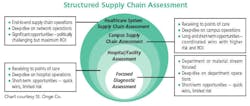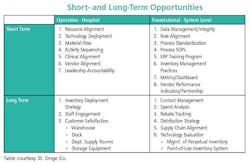Predict your supply chain future by creating it
As every new year begins, many folks take stock of their lives, their careers and the state of the world in which they live. This act of taking stock often leads to the making of what has become the tradition of the New Year’s Resolution – commitments to action that will lead to one’s self-improvement (most of which never come to fruition).
While the principle of the New Year’s assessment and ensuing resolutions may not always bear fruit, the premise behind it is both strong and prudent, and can be applied directly to today’s healthcare supply chain.
In today’s rapidly changing healthcare environment, the only thing that is certain is uncertainty. Standalone community hospitals are continually being eaten up by Integrated Delivery Networks (IDNs). Small IDNs are being acquired by bigger IDNs and mega-IDNs often merge to form even bigger organizations.
At every managerial level in every healthcare organization in the U.S. people are reasonably concerned that their personal future, as well as the future of the organization they work for is apt to be impacted by the sweep of organizational change. Both people and organizations find themselves asking the same question: What should we be doing to give ourselves and our organization the best chance to survive and prosper?
The first step applies to both people and organizations: Assess yourself.
Supply Chain assessments are usually imposed on people, if they are done at all. They have a punitive air about them, and the Supply Chain leaders that have such exercises imposed upon them tend to be not long for their present jobs.
But what about taking the initiative and requesting a review of your current operation? What is the benefit to you and your organization?
The answer: A detailed Supply Chain assessment will prepare both you and your organization to deal with whatever the future brings. It will lead to performance improvement, operational savings and position your organization for optimal performance in a highly-disruptive environment.
Supply Chain assessments can go from high-level to granular (See chart below).
At the macro level, a structured review of operations can begin at the system level to assess overall operating efficiency and identify opportunities, along with an estimated Return on Investment, and work its way down to the individual entity level and even make its way into the activities within a single department or function. Such an exercise, as performed by people experienced in such work and utilizing multi-site data and industry-proven Key Performance Indicators (KPI), will often reveal opportunities that you, being so close to the operation and so taken up in day-to-day demands, may not have seen.
A structured Supply Chain Assessment performed by an experienced firm will provide you with information that can become the basis of a long-term Supply Chain Master Plan – one that will help your organization develop a planned approach to the challenges of both today and tomorrow. If you are a standalone community hospital trying to keep your head above water, a small IDN trying to compete with bigger IDNs in your market or even a mammoth IDN faced with making clear the complexities of several disparate systems existing simultaneously, such an initiative will help you see what you need to do to move forward successfully.
The results of such an exercise (pictured below) will identify gaps between your current state and the highly-proficient operations and will allow you to work with your team to develop a plan for both short- and long-term opportunities for your organization at micro and macro levels:
Commissioned with the support of senior leadership, and conducted by an experienced professional organization with the input of key stakeholders in your organization, the result of a Strategic Supply Chain Assessment will be the building blocks for developing a formal, living roadmap to lead you into the future. As a Supply Chain leader, you will be armed with better information with which to develop operating budgets and operational strategies. As an organization, your system or hospital will be poised to survive and thrive in today’s shark-infested waters and your organization will see you as a visionary leader who has brought evidence-based planning to a complicated environment.
Graphic elements courtesy St. Onge Company
About the Author



